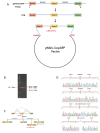A novel variant in the SPTB gene underlying hereditary spherocytosis and a literature review of previous variants
- PMID: 39135028
- PMCID: PMC11318180
- DOI: 10.1186/s12920-024-01973-w
A novel variant in the SPTB gene underlying hereditary spherocytosis and a literature review of previous variants
Abstract
Background: Hereditary spherocytosis (HS, MIM#612641) is one of the most common hereditary hemolytic disorders. This study aimed to confirm a novel variant's pathogenicity and reveal a patient's genetic etiology.
Methods: The clinical data of a patient with HS who underwent genetic sequencing at the Children's Hospital of Chongqing Medical University were reviewed retrospectively. In silico prediction and in vitro minigene splicing reporter system were then conducted on the detected variant to analyze its intramolecular impact. A summary of the literature related to HS due to SPTB gene variants was also presented.
Results: A novel variant (c.301-2 A > G) in the SPTB gene (NM_001024858.4) was identified in the proband. Using Sanger sequencing, we conclusively confirmed that the inheritance of the variant could not be traced to the biological parents. The in vitro minigene assay revealed three different transcripts derived from the c.301-2 A > G variant: r.301_474del, r.301_306delCCAAAG, and r.301-1_301-57ins. Through a literature review, patients with HS who had been genotypically validated were summarized and the SPTB gene variant profile was mapped.
Conclusion: We identified a splicing variant of the SPTB gene, thus confirming its aberrant translation. The novel variant was the probable genetic etiology of the proband with HS. Our findings expanded the variant spectrum of the SPTB gene, thus improving the understanding of the associated hereditary hemolytic disorders from a clinical and molecular perspective and contributing to the foundation of genetic counseling and diagnosis.
Keywords: SPTB gene; Hereditary spherocytosis; Minigene; Novel variant.
© 2024. The Author(s).
Conflict of interest statement
The authors declare no competing interests.
Figures




Similar articles
-
A novel essential splice site variant in SPTB in a large hereditary spherocytosis family.Mol Genet Genomic Med. 2021 May;9(5):e1641. doi: 10.1002/mgg3.1641. Epub 2021 May 4. Mol Genet Genomic Med. 2021. PMID: 33943044 Free PMC article.
-
Whole exome sequencing identified a novel mutation (p.Ala1884Pro) of β-spectrin in a Chinese family with hereditary spherocytosis.J Gene Med. 2019 Feb;21(2-3):e3073. doi: 10.1002/jgm.3073. Epub 2019 Feb 11. J Gene Med. 2019. PMID: 30690801
-
[Hereditary spherocytosis due to a novel c.5798+1G>A variant of the SPTB gene].Zhonghua Yi Xue Yi Chuan Xue Za Zhi. 2020 Jan 10;37(1):17-20. doi: 10.3760/cma.j.issn.1003-9406.2020.01.005. Zhonghua Yi Xue Yi Chuan Xue Za Zhi. 2020. PMID: 31922588 Chinese.
-
Literature review on genotype-phenotype correlation in patients with hereditary spherocytosis.Clin Genet. 2022 Dec;102(6):474-482. doi: 10.1111/cge.14223. Epub 2022 Sep 26. Clin Genet. 2022. PMID: 36071563 Review.
-
Molecular Genetic Mechanisms of Hereditary Spherocytosis: Current Perspectives.Acta Haematol. 2018;139(1):60-66. doi: 10.1159/000486229. Epub 2018 Jan 22. Acta Haematol. 2018. PMID: 29402830 Review.
Cited by
-
Identification of a novel SPTB gene splicing mutation in hereditary spherocytosis: a case report and diagnostic insights.Front Genet. 2025 Jan 30;15:1522204. doi: 10.3389/fgene.2024.1522204. eCollection 2024. Front Genet. 2025. PMID: 39959857 Free PMC article.
-
Linking regulatory variants to target genes by integrating single-cell multiome methods and genomic distance.Nat Genet. 2025 Jul;57(7):1649-1658. doi: 10.1038/s41588-025-02220-3. Epub 2025 Jun 12. Nat Genet. 2025. PMID: 40506539
References
-
- Gallagher PG. Difficulty in diagnosis of Hereditary Spherocytosis in the Neonate. Pediatrics, 2021. 148(3). - PubMed
Publication types
MeSH terms
Substances
Grants and funding
- xyxthjb-2023-006/Public Welfare Project for Rare Blood Disorders in the field of Hematology in China
- xyxthjb-2023-006/Public Welfare Project for Rare Blood Disorders in the field of Hematology in China
- xyxthjb-2023-006/Public Welfare Project for Rare Blood Disorders in the field of Hematology in China
- xyxthjb-2023-006/Public Welfare Project for Rare Blood Disorders in the field of Hematology in China
- xyxthjb-2023-006/Public Welfare Project for Rare Blood Disorders in the field of Hematology in China
- xyxthjb-2023-006/Public Welfare Project for Rare Blood Disorders in the field of Hematology in China
- xyxthjb-2023-006/Public Welfare Project for Rare Blood Disorders in the field of Hematology in China
- xyxthjb-2023-006/Public Welfare Project for Rare Blood Disorders in the field of Hematology in China
- xyxthjb-2023-006/Public Welfare Project for Rare Blood Disorders in the field of Hematology in China
LinkOut - more resources
Full Text Sources

